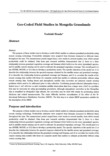Geo-Coded Field Studies in Mongolia Grasslands
JIRCAS international symposium series
| ISSN | 13406108 |
|---|---|
| NII recode ID (NCID) | AA1100908X |

Full text
intlsymp-8_101-106.pdf961.5 KB
The purpose of these studies was to develop a model which enables to estimate grassland productivity using remote sensing technology. Productivity estimates were acquired from biomass measured at different times throughout the year. The measurement period ranged from a few weeks to several months, from which annual productivity could be obtained. Data from past research activities demonstrated that 1) there is a close relationship between grassland vegetation coverage and biomass which holds true for every (grassland) species, and 2) satellite remote sensing can be used to estimate the grassland vegetation coverage. The overall goal is to use AVHRR, MODIS, or GLI data to develop a productivity model. The specific objectives of the model are 1) to describe the relationship between the spectral response obtained by the satellite sensor and grassland coverage, 2) to describe the relationship between grassland coverage and biomass, and 3) to correlate the results of the remote sensing data models with those of a separate model that enables to estimate productivity. without using remote sensing data. Scaling issues and atmospheric satellite data correction are inherent remote sensing problems which need to be addressed prior to data collection. Combining ground-collected information from a limited area (~ m2) with low- or mid- resolution satellite observation data from a larger area (~km2) is a problem that may be overcome by using geo-sampling procedures. Although atmospheric correction in the Mongolian data is simplified by Mongolia's high altitude, the correction may be dealt with simply by performing optical thickness and related measurements. The major difficulty involves normalization of the effect of the Bi-directional Reflectance Distribution Function (BRDF). The first step is to obtain BRDF parameters suitable for the description of the BRDF.
| Creator | Yoshiaki Honda |
|---|---|
| Publisher | Japan International Research Center for Agricultural Sciences |
| Available Online | |
| Issue | 8 |
| spage | 101 |
| epage | 106 |
| Language | eng |
